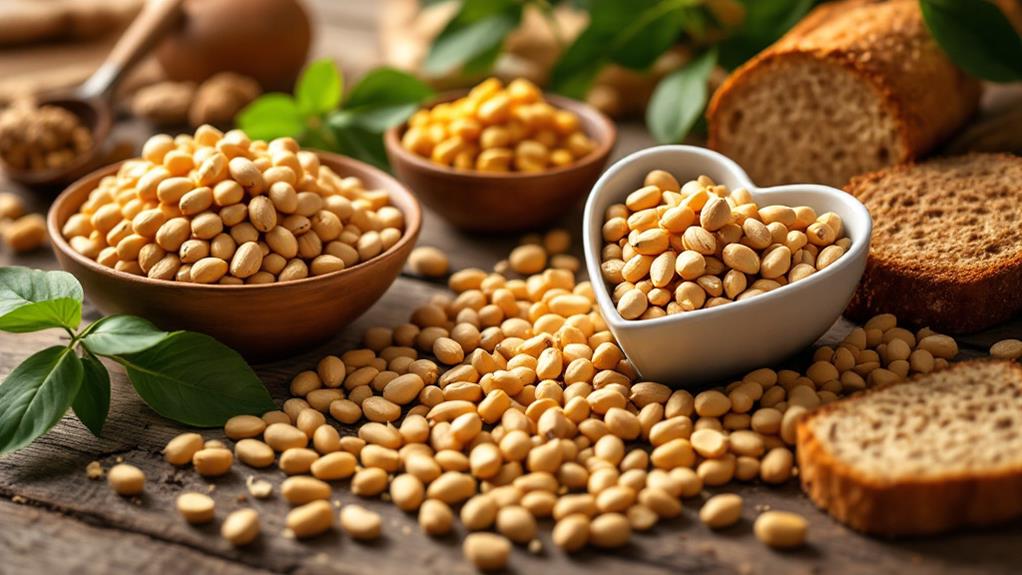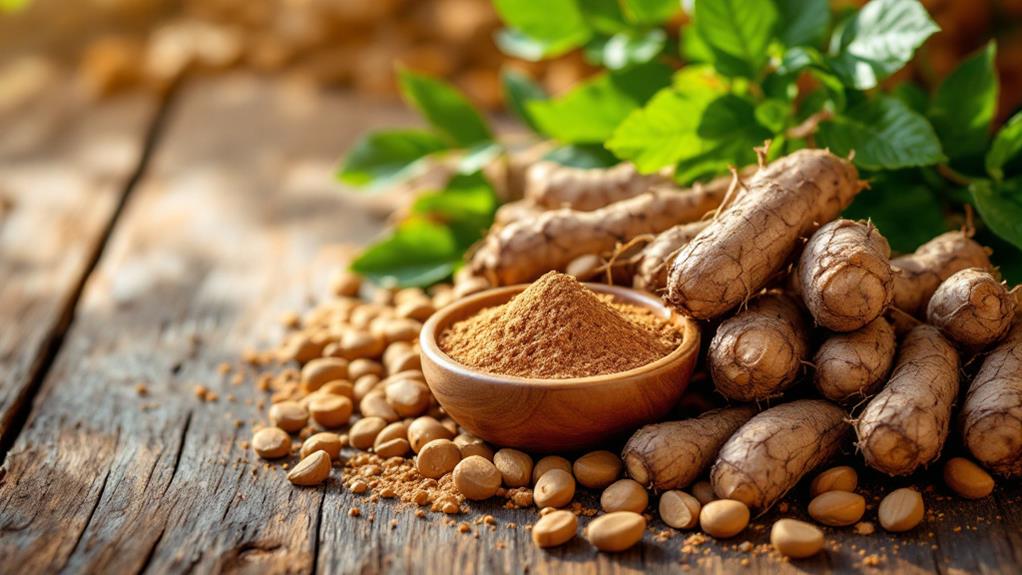Peanuts Are Legumes? You’re Nuts! Exploring the Origins of Peanuts
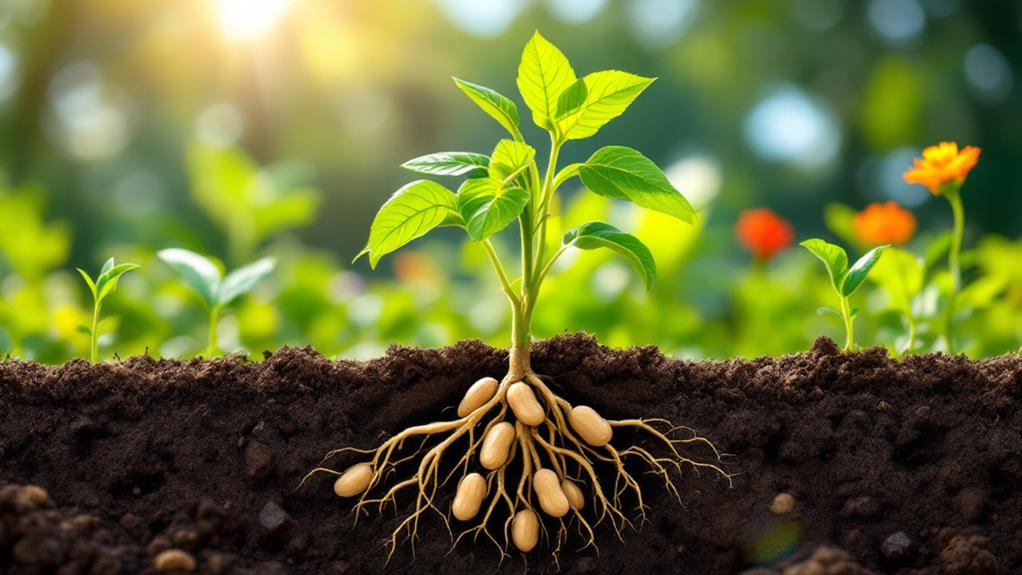
You might think peanuts are nuts, but they're actually legumes with a fascinating history. Tracing their roots back to ancient South America, peanuts were domesticated around 6,500 BC in Northern Peru. They held cultural and spiritual significance, often featured in rituals and art. Peanuts traveled across the globe, introduced to Africa and Asia by Portuguese traders in the 16th century, becoming integral in local cuisines. By the time they reached colonial America, peanuts were valued as a crucial food source. They're a nutritional powerhouse and a staple in economies worldwide. There's so much more to uncover about peanuts' fascinating expedition.
Ancient South American Roots
Peanuts, often overlooked in their significance, likely originated in South America, with archaeological evidence dating their domestication back to around 6,500 BC in Northern Peru. You've probably never considered just how deeply intertwined peanuts are with ancient South American culture. The Inca and other cultures of the region didn't just consume them; they saw peanuts as essential to life and death. Imagine the importance of a legume that was considered worthy of accompanying the deceased into the afterlife, as evidenced by jars of peanuts placed in ancient graves.
In these ancient times, peanuts weren't merely a source of sustenance; they were embedded in the cultural tapestry of South America. Pottery from ancient Peru showcases peanut-shaped designs, underscoring their significance as far back as 3,500 years ago. This wasn't just food; it was a symbol, a motif in their art and daily life. Central Brazilian tribes even mixed ground peanuts with maize to create celebratory beverages, highlighting the legume's role in festive occasions. By the time Europeans arrived, peanuts had spread throughout South America, demonstrating their crucial role in the continent's ancient cultures.
Peanuts in Religious Rituals
Throughout history, diverse ancient Andean cultures have woven peanuts into their religious rituals, underscoring their profound spiritual significance. As you investigate these customs, you'll uncover that peanuts weren't just food; they were a bridge to the divine. The Incan societies, for example, offered peanuts to Viracocha, the creator god, highlighting their sacred role. They believed that peanuts, as food for the afterlife, would accompany the deceased on their spiritual voyage. By placing peanuts in graves, they guaranteed sustenance for the departed souls in the world beyond.
You'll also find that peanuts were essential to South American ceremonial practices. Archaeological evidence from late Moche sites shows that peanuts were the second most consumed crop after maize, revealing their importance in both daily life and religious ceremonies. During community feasts and celebrations, peanuts played a starring role, reflecting their cultural and spiritual value. Artistic expressions, like Moche jars shaped like peanuts, further illustrate their deep-rooted significance. Through these rituals and symbols, peanuts transcended their role as mere sustenance, becoming a crucial part of the spiritual and cultural tapestry of ancient Andean societies.
Nutritional Powerhouse
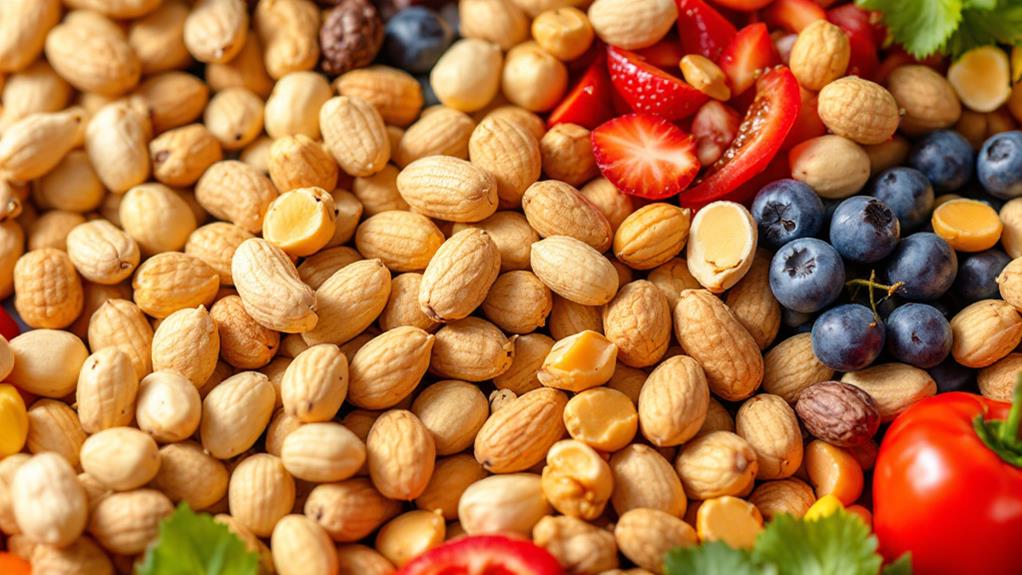
Many might not realize just how much nutritional value peanuts pack into their small shells. Regarding peanut production, each little nut is like a powerhouse of protein. With 25-30% of their weight coming from protein, peanuts stand out as a top choice for plant-based nutrition. Whether you're adding them to a meal or snacking on them solo, they provide a substantial protein enhancement that's hard to beat.
But that's not all—peanuts are rich in healthy fats. These fats, mainly monounsaturated and polyunsaturated, play a significant role in improving heart health. So, as you munch on peanuts, you're not just enjoying a tasty treat; you're also doing your heart a favor.
Incorporating peanuts into your diet also means you're getting vital vitamins and minerals like B vitamins, copper, magnesium, and phosphorus. Plus, they're a good source of antioxidants, such as resveratrol, which help combat oxidative stress and inflammation. A small 1-ounce serving of peanuts packs about 170 calories, providing a quick energy enhancement when you need it. So, next time you reach for a snack, keep in mind that peanuts deliver nutrition in every bite.
Artistic and Cultural Significance
Beyond their nutritional benefits, peanuts hold a rich artistic and cultural significance. For over 3,500 years, societies have been inspired by peanuts, creating beautiful artistic representations. The Moche society in ancient Peru, for example, crafted jars shaped like peanuts, adorned with intricate designs that showcase their artistic prowess. These artifacts highlight the cultural importance of peanuts as more than just a food source.
Peanuts carry cultural significance in burial rites of ancient Andean cultures, symbolizing sustenance for the afterlife. This practice underscores the profound role peanuts played in spiritual and daily life. Their status as a revered cash crop is evident in modern celebrations. In Virginia, annual festivals highlight peanuts' impact on local economies and cuisine, celebrating this humble legume's contributions.
Peanuts also have deep cultural roots in Africa, where the term "goober" originates from the Congo name "nguba." This reflects their significance and historical spread to American culture. Peanuts are embedded in multiple cultural expressions and dishes, such as the traditional mazamorra morada, enjoyed during community feasts. You can appreciate how peanuts have transcended borders, enriching artistic and cultural landscapes globally.
- Moche peanut-shaped jars
- Andean burial rites
- Virginia festivals
European Encounter

When Europeans initially encountered peanuts in the 15th century, possibly through adventurers like Columbus or de las Casas, they saw them as an intriguing novelty. These small, hardy legumes, scientifically known as Arachis hypogaea, piqued curiosity among those who had never seen such a crop before. Spanish explorers took the peanut back to Europe, where it quickly found a place in their agricultural landscape. Yet, it wasn't until later that peanuts began to gain recognition as a viable food source.
In Europe, the peanut initially struggled to compete with established crops, overshadowed by more familiar staples. However, its expedition didn't end there. By the 16th century, peanuts traveled beyond Europe, reaching as far as India and China. This spread marked the beginning of their broader global influence. While Europe was slow to accept peanuts as a major crop, their introduction to the Americas and future continents would eventually cement their place as a staple food source.
You can see how the peanut's introduction to Europe was just the start of its global expedition, setting the stage for its eventual rise in agriculture across diverse continents.
Journey to Africa and Asia
The expedition of peanuts to Africa and Asia marks a significant chapter in their global spread. Portuguese traders introduced peanuts to Africa in the 16th century. This legume thrived, becoming a staple due to its nutritional value and adaptability to local growing conditions. Known as "groundnuts" in Africa, peanuts hold cultural significance and are considered spiritually meaningful. As slave ships traversed the Atlantic, West African enslaved people brought peanuts to North America, cultivating them as a crucial food source.
You can appreciate peanuts' passage with these key highlights:
- Introduction to Africa: Portuguese traders brought peanuts in the 16th century, where they quickly became a staple due to their adaptability and nutritional value.
- Cultural Significance: In Africa, peanuts, or "groundnuts," are culturally significant, seen as plants possessing a soul.
- Spread to Asia: Peanuts reached Asia in the 16th and early 17th centuries, with India and China incorporating them into their cuisines.
In Asia, the crop's versatility made it an fundamental part of local diets. Over time, peanuts gained prominence as an agricultural commodity, becoming economically significant in Africa and Asia. Their passage across continents highlights their adaptability and importance in global trade.
Peanuts in Colonial America
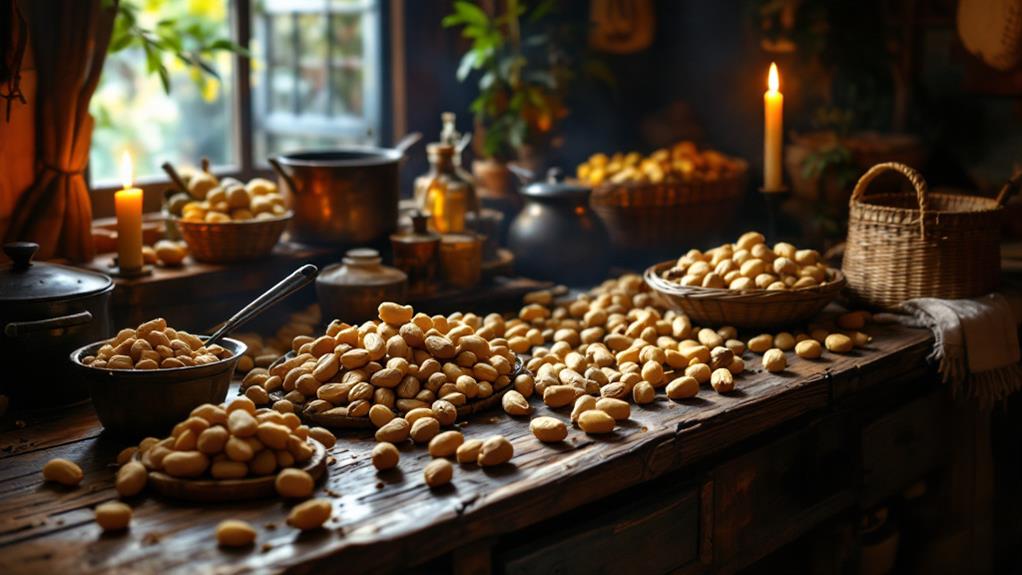
Peanuts' expedition across continents continued as they made their way to colonial America. In 1769, they were initially referenced, likely introduced via Caribbean or slave ships from Africa. At the outset, peanuts were viewed as food for the poor, offering an inexpensive, nutritious option. This perception didn't stop prominent figures like Thomas Jefferson from cultivating them. Jefferson, known for his agricultural interests, saw peanuts as a valuable crop for American farmers.
As the 19th century unfolded, peanuts began to shed their humble reputation, gaining popularity as a snack food. Street vendors capitalized on this trend, selling peanuts at public events, which ultimately led to the term "peanut galleries." However, the true turning point for peanuts came during the Civil War. Soldiers faced food shortages, and peanuts provided a reliable, protein-rich supplement. Furthermore, the demand for peanut oil surged, further embedding peanuts in American life.
Mechanization and Mass Production
Many factors played a role in transforming peanuts from a humble snack to a major agricultural commodity, but mechanization was key. In the early 1900s, the invention of gas-powered harvesting machines changed the game for peanut processing in North America. These machines made it possible to cultivate and harvest peanuts more efficiently, turning them into a valuable cash crop. As mechanization improved, so did the quality and uniformity of peanuts, making them more appealing commercially.
With increased production, the demand for peanut products like peanut butter and peanut oil surged dramatically. You might wonder how mechanization benefited the peanut industry:
- Efficiency: Mechanized harvesting drastically reduced the time and labor needed, leading to a surge in production, especially during and after the World Wars when nutritious food options were in high demand.
- Quality: Uniform quality due to mechanization increased peanuts' commercial appeal, enhancing their market value.
- Economic Impact: Peanuts became a significant part of North America's agriculture, contributing over $4 billion annually to the economy.
With these advancements, peanuts solidified their place as a major agricultural commodity, establishing the U.S. as a leading exporter in the global market.
Global Economic Influence
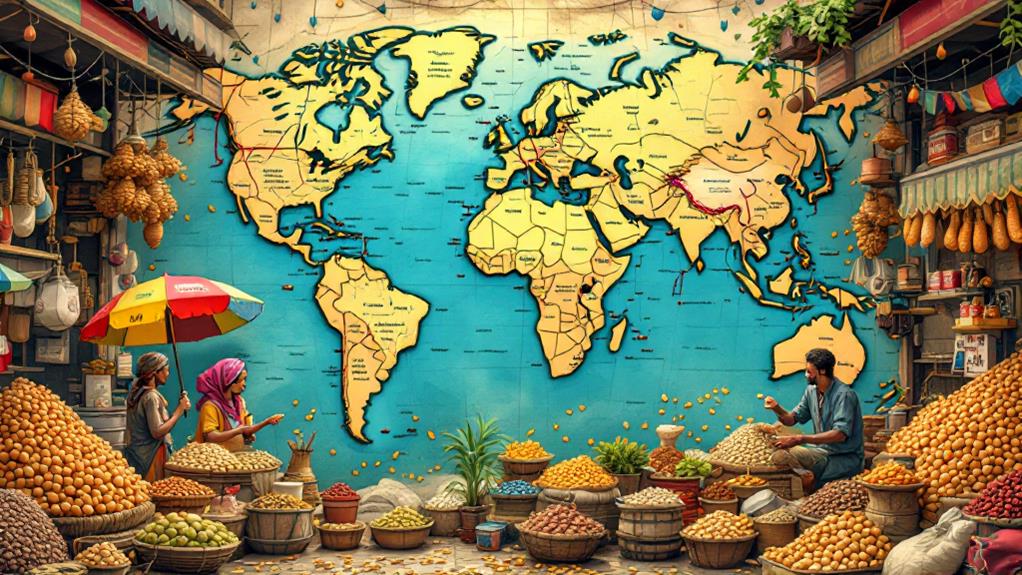
In the domain of global agriculture, peanuts wield substantial economic influence, contributing prominently to economies across diverse continents. You probably didn't realize just how much peanuts have Altered the World economically. In the United States alone, these legumes add over $4 billion annually to the economy, making them a vital cash crop. This impact is largely due to efficient peanut harvesting techniques, which have advanced remarkably since the early 20th century. These innovations have transformed peanuts from humble origins into a staple on grocery shelves.
The U.S. isn't the only country benefiting from peanuts. Globally, nations like China, India, Nigeria, and Argentina also boast considerable peanut production, highlighting the crop's widespread economic footprint. During both World Wars, the demand for nutritious food skyrocketed, enhancing peanut production and embedding them deeper into world markets. This surge wasn't just about feeding soldiers; it catalyzed a shift in global agricultural practices.
Even culturally, peanuts have left their mark in the U.S. Street vendors selling roasted peanuts at events like circuses and baseball games helped cement their place in American life and economy, showing how intertwined peanuts are with global economic influence.

